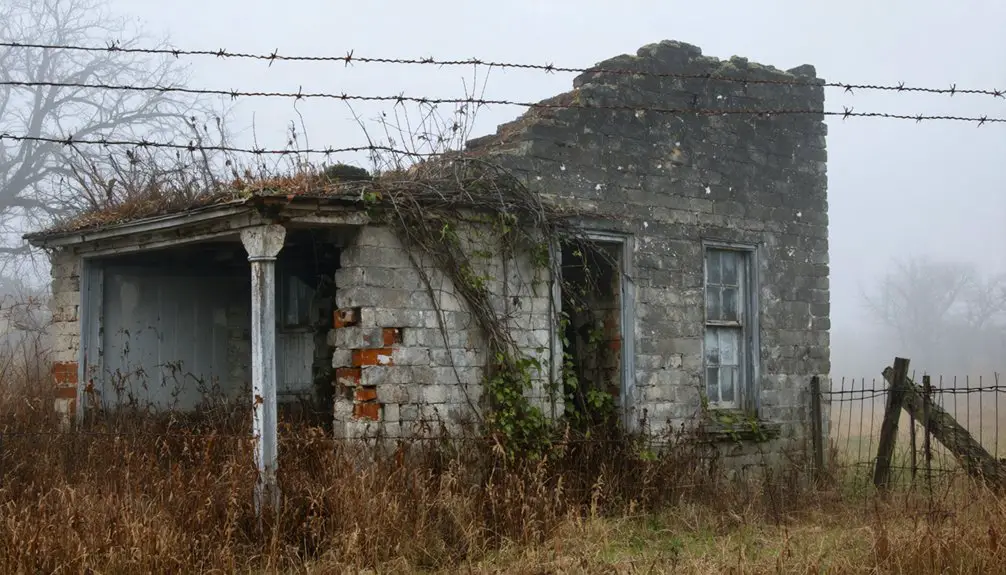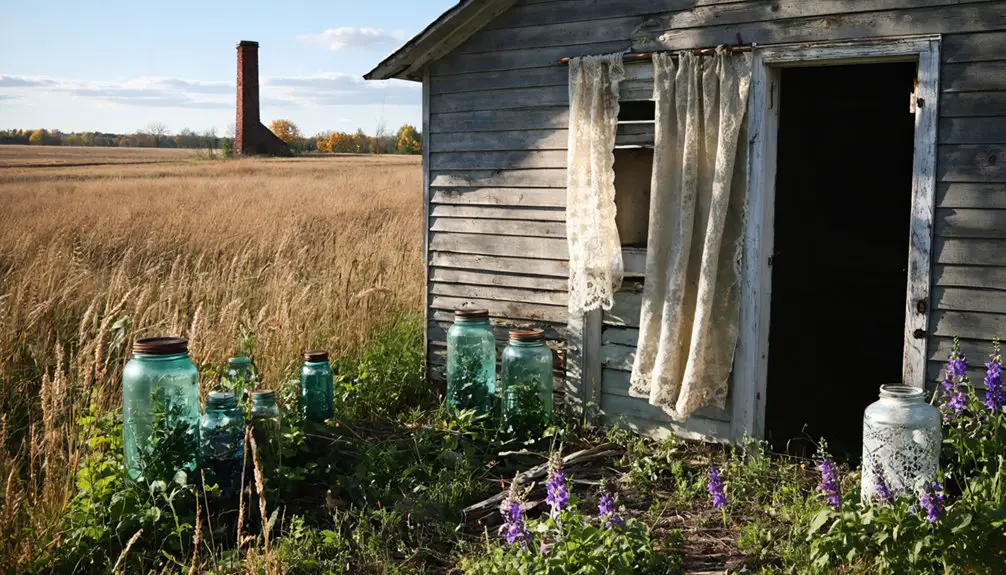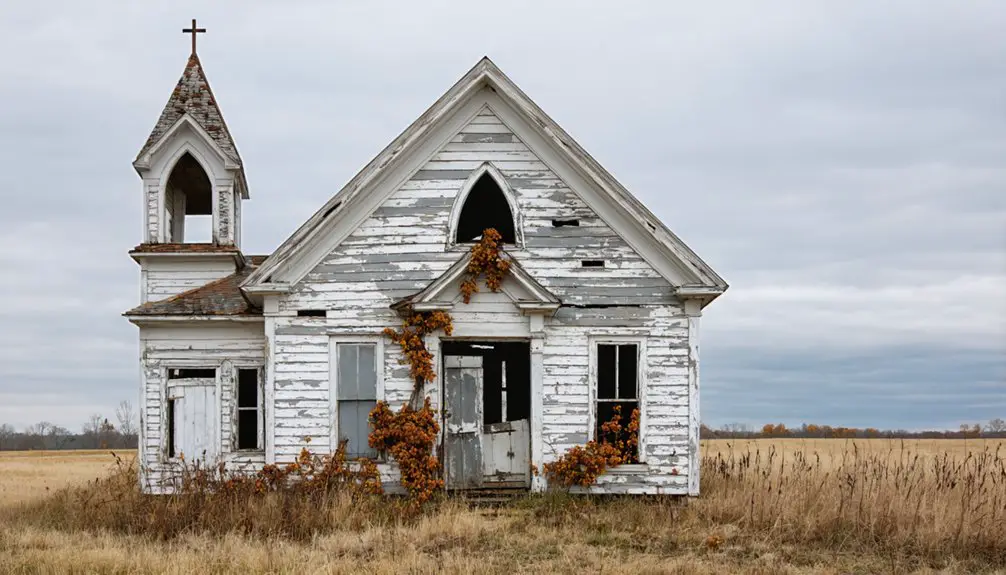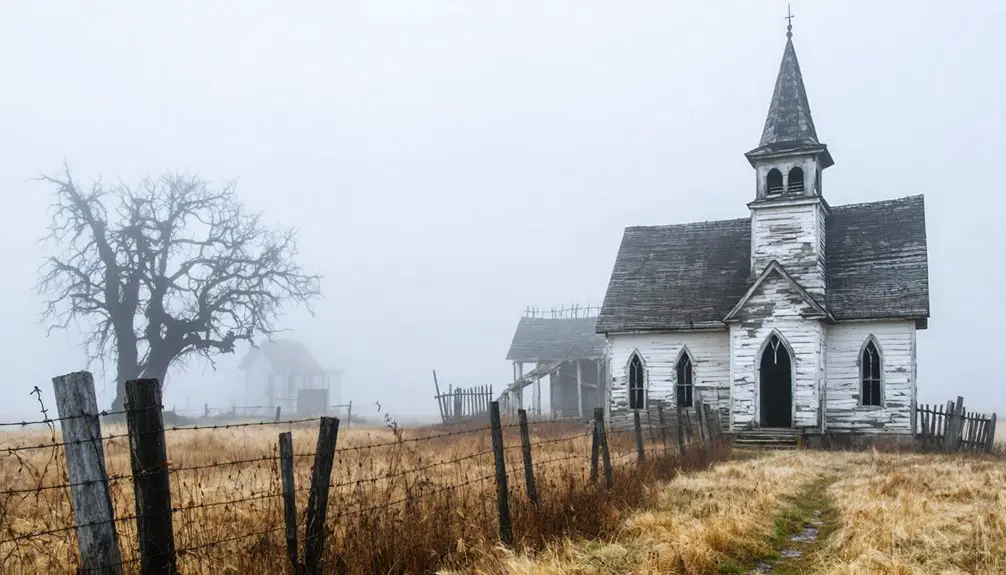You’ll discover Possum Trot‘s weathered remnants 5.5 miles southwest of Nixa on Missouri Route M, where this rural settlement earned its name from abundant local opossums. In the mid-1800s, the Wilson family’s general store and Fairview School anchored this tight-knit farming community in Stone County’s rolling Ozark hills. While the ghost town‘s structures have largely vanished, its legacy lives on through the stories of pioneers who carved out their lives in this distinct corner of Missouri.
Key Takeaways
- Possum Trot was an unincorporated rural settlement located 5.5 miles southwest of Nixa, Missouri on Route M.
- The community centered around the Wilson family general store and Fairview School, which served as primary gathering places.
- Originally named Self, the settlement adopted “Possum Trot” due to frequent opossum sightings in the area.
- The settlement emerged during mid-1800s westward expansion but never incorporated, eventually declining into ghost town status.
- Situated in northeastern Stone County’s Ozark hills, the former settlement area features rolling terrain and mixed hardwood forests.
The Rise and Fall of a Rural Missouri Settlement
While many small Missouri settlements faded into obscurity during the 20th century, Possum Trot’s story exemplifies the typical rise and decline of rural Ozark communities.
You’ll find its remnants 5.5 miles southwest of Nixa on Route M, where community dynamics once centered around a general store run by the Wilson family and the Fairview School, locally known as Possum Trot School. Similar to a dogtrot house design, the school featured a central breezeway that helped with ventilation during hot summer months.
The settlement’s agrarian lifestyle supported modest but independent farming families, with the general store serving as their commercial hub.
However, the pull of bigger towns and better opportunities led to rural migration, gradually emptying this northeastern Stone County hamlet. Before Kansas City became Kansas City, Possum Trot was actually considered as a potential name for the burgeoning settlement.
Like countless rural communities, Possum Trot slowly faded as its residents sought new lives in Missouri’s growing urban centers.
Today, you’ll only discover the old schoolhouse and a single house standing as silent witnesses to Possum Trot’s past, preserving a chapter of Missouri’s frontier heritage.
A Tale Behind the Peculiar Name
You’ll find the origins of Possum Trot’s name embedded in Missouri’s pioneer tradition of naming places after local wildlife encounters, particularly the common sight of opossums trotting along rural paths.
Similar to the Coontown sawmill named for its abundant raccoons, this pattern of wildlife-inspired naming was common in early Missouri settlements.
The historical significance of this name was highlighted when it was considered as a name for Kansas City during its founding period.
While the name might’ve started as a humorous suggestion, it became firmly rooted in the community’s identity through its official use at the Fairview schoolhouse and Wilson family’s general store.
Though Possum Trot exists now only as a ghost town, its distinctive name preserves a slice of Missouri’s rural heritage, joining other colorful place names like Owl City and Rabbitville in telling the story of the state’s frontier settlement patterns.
Local Lore Lives On
Though many Missouri ghost towns fade into obscurity, Possum Trot‘s peculiar name lives on through a rich tapestry of local folklore.
You’ll find this whimsical name woven into regional stories, from its connection to Kansas City’s early naming suggestions to its enduring presence in Stone County’s history.
Located 5.5 miles southwest of Nixa on Route M, Possum Trot’s rural naming heritage reflects the frontier spirit of early settlers who drew inspiration from local wildlife and daily life.
While only the Fairview schoolhouse and a single home remain standing, the community’s legacy persists through storytelling. The town was originally known as Self before adopting its current name.
The name’s playful nature, once shared with nicknames like “Rabbitville,” captures the freedom and humor of America’s pioneer days, ensuring this ghost town’s place in Missouri’s cultural memory.
Origins of Rural Identity
As settlers established homesteads in northeastern Stone County during the early frontier days, Possum Trot emerged as more than just a whimsical name on Missouri’s rural landscape.
The community’s identity took shape through rural traditions and strong community ties, anchored by the Wilson family’s general store and the one-room Fairview schoolhouse.
You’ll find these distinctive elements that shaped Possum Trot’s character:
- Local wildlife and landscape features influenced the unique naming tradition
- The Wilson family’s general store served as a crucial community hub
- Fairview School (known as Possum Trot School) united generations through education
- Early settler families established deep roots through land cultivation
- The blending of practical and humorous rural naming customs reflected frontier spirit
These foundations created a distinct rural identity that, though the town stands empty today, continues to resonate through regional storytelling and cultural memory.
Name’s Historical Significance
While many Missouri ghost towns fade into obscurity, Possum Trot’s peculiar name continues to spark curiosity among local historians and preservationists.
You’ll find this name reflects the region’s rural naming conventions of the 19th century, when settlers commonly drew inspiration from local wildlife and daily frontier life.
The cultural impact of Possum Trot’s name extends beyond its literal meaning. While some claim it was once considered for Kansas City’s name, that’s merely folklore – though it illustrates how deeply such rural identifiers resonated with Missouri’s pioneer spirit.
The “trot” likely referred to a well-worn path, while “possum” nodded to the abundant wildlife.
Today, this distinctive name survives primarily through oral tradition and historical records, preserving a snapshot of early settlers’ practical approach to place-naming.
Life Around the Wilson General Store
During the early twentieth century, the Wilson General Store stood as the beating heart of Possum Trot, Missouri, where descendants of Jackson B. Wilson and Emma Stewart Wilson ran a thriving hub of community interactions and local economy. Much like Rich Pate’s Store, it became an essential gathering place for the townspeople. Similar to other rural communities, residents relied on horse-drawn wagons for their Saturday shopping trips.
You’d find the store conveniently located along Route M, about 5.5 miles southwest of Nixa, within walking distance of Fairview School and church.
- Farmers gathered for card games and planned Friday night coon hunts
- Local men exchanged news while picking up essential farming supplies
- Milk drivers stopped by on their routes to Murfreesboro Milk Company
- Residents purchased groceries, feed, hardware, and gasoline
- Neighbors socialized over Double Cola and tobacco products
The store’s influence extended beyond mere commerce, creating bonds that held this rural community together until Possum Trot’s eventual decline into a ghost town.
Legacy of the Fairview Schoolhouse

Once bustling with the energy of young learners, Fairview Schoolhouse, commonly known as Possum Trot School, served as the educational cornerstone for generations of Stone County children.
You can imagine the one-room schoolhouse filled with students from grades 1-8, seated at slant-top desks while their teacher conducted spelling bees and arithmetic contests. Students practiced their penmanship at eight-foot-long benches facing the teacher’s desk.
Today, only remnants of this essential institution remain, yet its legacy endures through the educational traditions it fostered.
The schoolhouse wasn’t just a place of learning – it was where community gatherings strengthened local bonds through shared experiences. Located in the scenic Ozarks region, the school reflected the area’s rural character and close-knit community values.
In these hallowed halls, neighbors became family through potlucks, socials and celebrations that wove the fabric of rural life.
While modern roads and newer facilities eventually led to its abandonment, Fairview’s story lives on through historical records, oral histories, and the physical traces that remind us of Possum Trot’s vibrant past.
Geographic Location and Surroundings
You’ll find Possum Trot nestled in northeastern Stone County‘s rolling Ozark hills, approximately 5.5 miles southwest of Nixa, Missouri.
The ghost town’s terrain features a mix of hardwood forests and open farmland, characteristic of the region’s karst topography. Several religious landmarks dot the surrounding area, including Union Ridge Church nearby.
Missouri Route M provides the primary access to this rural site, while nearby U.S. Highway 65 connects visitors to the larger Springfield metropolitan area.
Distance From Major Cities
Possum Trot sits approximately 12 miles southeast of Springfield, Missouri‘s third-largest city, making it easily accessible for history enthusiasts and ghost town explorers.
The town’s location offers strategic urban connectivity to several major regional landmarks and metropolitan areas across the state.
- 160 miles west of Kansas City’s bustling urban center
- 200 miles south-southwest of St. Louis’s historic downtown
- 15 miles from Springfield-Branson National Airport
- 5.5 miles southwest of Nixa’s growing community
- Easily reached via Missouri Route M
You’ll find Possum Trot positioned within a day’s drive of Missouri’s largest cities, yet tucked away in Stone County’s peaceful countryside.
This location provides the perfect balance of accessibility while maintaining the authentic ghost town atmosphere that draws visitors to explore its remaining structures.
Natural Features and Terrain
Nestled within northeastern Stone County’s rolling hills, the ghost town rests on typical Ozark Plateau terrain characterized by limestone bedrock and karst formations.
You’ll find the natural landscape dotted with small streams and creeks that wind through mixed hardwood forests of oak and hickory trees. The area’s ecological diversity thrives in the surrounding conservation lands, where native flora supports wildlife like deer, possums, and various bird species.
The region’s distinctive features include exposed bluffs, rock outcrops, and underground cave systems that shape the local hydrology.
You’ll notice how the humid climate and seasonal variations sustain the forest’s natural regeneration, while the terrain’s elevation changes create unique microclimates in the hills and valleys, preserving the rugged character of this Ozark Highland setting.
Access Routes and Highways
Three primary routes provide access to the abandoned settlement of Possum Trot, with Missouri Route M serving as the main highway connection.
You’ll find it positioned 5.5 miles southwest of Nixa at coordinates 36.97861°N, 93.42917°W. Road conditions can be challenging, especially on the rural lanes branching off Route M.
Key access points to evaluate:
- Interstate 44 northeast via Springfield-Nixa corridor
- Missouri Route 14 and Route 125 through Stone County
- U.S. Route 160 providing southern regional connectivity
- Local county roads reaching surrounding farmland
- Secondary routes connecting to nearby ghost towns
Due to its ghost town status, you’ll encounter limited infrastructure and varying road quality.
Private vehicle access is essential, as no public transportation serves the area. The site’s preservation relies on mindful navigation of these rural pathways.
Historical Significance in Stone County
During the westward expansion of Missouri in the mid-1800s, a small but notable settlement emerged in northeastern Stone County that would later be known as Possum Trot.
Early settlers carved out a life along Flat Creek and the James River, establishing agricultural practices that would sustain their community for generations.
You’ll find that Possum Trot’s impact on Stone County’s development was uniquely tied to its one-room schoolhouse, locally known as Fairview School, and the Wilson family’s general store.
While the community never incorporated as an official town, it represented the pioneering spirit of rural Missouri life.
Though the settlement didn’t benefit from the later tourism boom around Table Rock Lake, its legacy lives on through the remaining ruins and stories, offering a glimpse into the region’s frontier heritage.
Remnants and Ruins Today

Although time has claimed most of Possum Trot’s original structures, you’ll find sparse remnants at its location 5.5 miles southwest of Nixa along Missouri Route M.
Today’s remnants exploration reveals a limited but intriguing glimpse into this former settlement’s past.
The most notable surviving features include:
- One-room Fairview (Possum Trot) School that once educated local children through eighth grade
- A single house structure with visible remains
- Former general store site, though no longer operational
- Foundation elements scattered throughout the area
- Natural overgrowth covering various historical markers
Ruins preservation faces challenges due to the site’s proximity to protected conservation land, which restricts access and documentation efforts.
You’ll need to navigate smaller local roads to reach these historical traces, as modern development hasn’t touched this quiet corner of Stone County.
Preserving Possum Trot’s Memory
While most Missouri ghost towns fade into obscurity, Possum Trot’s memory lives on through diverse preservation efforts.
You’ll find the town’s heritage preserved through community storytelling sessions, where local residents and descendants share tales about the Wilson family’s general store and life at the Fairview schoolhouse. Historical societies actively document these narratives, while radio broadcasts and podcasts spread the stories to wider audiences.
Physical preservation efforts focus on protecting the remaining structures and establishing markers at the site’s coordinates (36°58′43″N 93°25′45″W).
Educational programs incorporate Possum Trot’s history into local curricula, while museums in Stone County showcase artifacts and photographs.
Through digital archives, GIS mapping, and online platforms, you can explore this fascinating piece of Missouri’s past from anywhere in the world.
Frequently Asked Questions
What Wildlife and Plant Species Were Common in Early Possum Trot?
You’d find early flora like oak and hickory trees alongside pawpaw shrubs, while local fauna included opossums, white-tailed deer, wild turkeys, and various aquatic species in creek habitats.
Did Any Notable Crimes or Mysteries Occur in Possum Trot?
You’re barking up the wrong tree looking for unsolved cases or historical crimes here. Based on available records, no documented mysteries or significant criminal activity occurred in this location.
What Native American Tribes Previously Inhabited the Possum Trot Area?
You’ll find the Osage tribe dominated this Missouri River region originally, while the Shawnee later established significant influence through trade and settlements near the river’s confluence with the Kaw.
Were There Any Documented Paranormal Experiences in Possum Trot?
You’ll find no officially documented ghost sightings in the area, though local folklore hints at haunted locations. Despite the town’s eerie abandoned atmosphere, verified paranormal experiences remain mysteriously absent from historical records.
How Did Residents Celebrate Holidays and Special Occasions in Possum Trot?
You’d have found holiday traditions centered around the one-room schoolhouse and church, with community potlucks, religious services, Christmas plays, and special celebrations bringing neighbors together for intimate gatherings.
References
- https://www.kcur.org/arts-life/2021-01-30/rumor-has-it-that-kansas-city-was-nearly-named-possum-trot-is-that-true
- https://en.wikipedia.org/wiki/Possum_Trot
- https://www.youtube.com/watch?v=wiF41PIwD74
- https://www.youtube.com/playlist?list=PL4jqwLUrhjNScUWj03mXzSKyBNMNqZHGw
- https://www.onlyinyourstate.com/trip-ideas/missouri/road-trip-through-mo-ghost-towns
- https://collections.shsmo.org/manuscripts/columbia/C2366/pemiscot-county
- https://sites.rootsweb.com/~motttp/history/ghost_towns/index.htm
- https://rutherfordtnhistory.org/possum-trot-a-place-called-home/
- https://stone.mogenweb.org/stories/hurley.htm
- https://mostateparks.com/sites/mostateparks/files/Stone TARP PII Report.pdf



